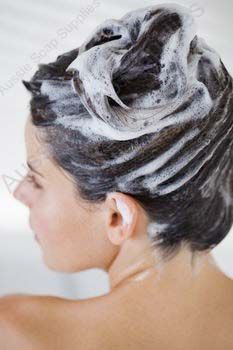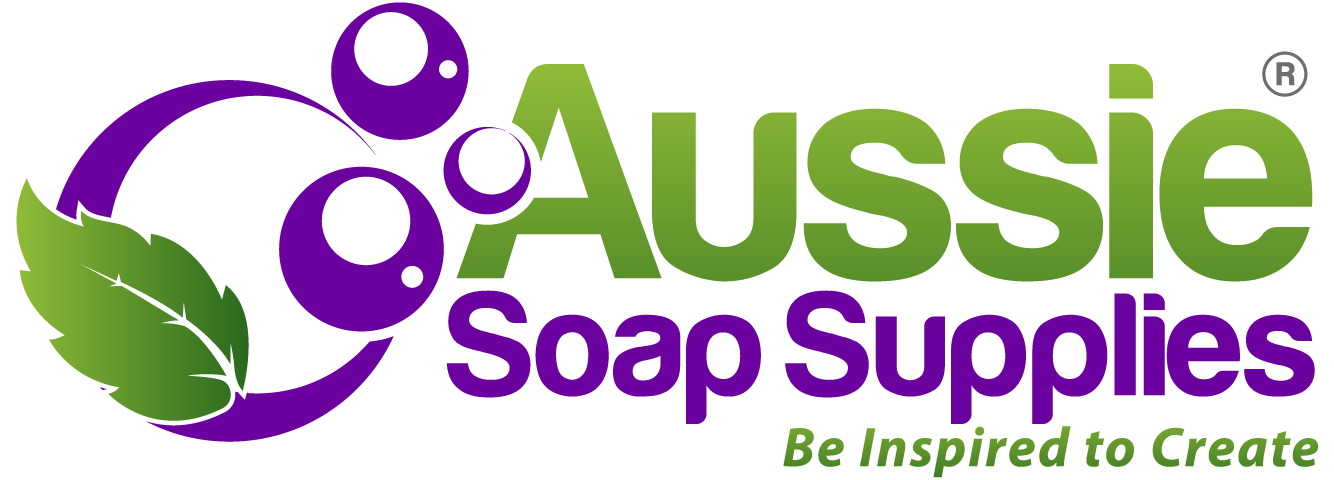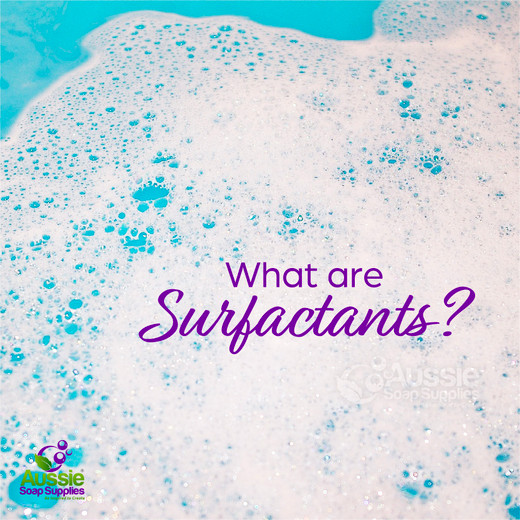Surfactant is Not a Dirty Word!
Pardon the pun! Many people are a little wary of the word "surfactant" and tend to only associate it with Sodium Lauryl Sulphate (SLS) and all "those bad ingredients". In fact we use and sell SLSA (Sodium Lauryl Sulphoacetate) which is a much milder surfactant than SLS and is used in solid Bubble Bars and Foaming Bath blends.
So, what are they? If you Google Wiki you'll see this: Surfactants are compounds that lower the surface tension (or interfacial tension) between two liquids or between a liquid and a solid. Surfactants may act as detergents, wetting agents, emulsifiers, foaming agents, and dispersants.
In other words, they bubble and lather, they change the surface tension, they solublise, they emusify and disperse - and they clean!
However, these sorts of surfactants are not derived from natural sources, but the other ingredients you will see explained below ARE derived from natural, vegetable sources. We had been asked so often for a more natural alternative to SLS shampoos, for liquid shampoo, solid shampoo bars and hair conditioner recipes, and to make the following ingredients available so that you, our customers, can replicate commerical shampoos and other foamy products - but with less "bad stuff" in it, and using more natural ingredients.
Morgan, Earthchylde, describes this subject clearly below:
Surfactant Basics
The word "surfactant" is an abbreviation of the words SURFace ACTive AgeNT
How do surfactants work?
They work in very much the same way that handmade soaps work. When we are dirty we wash with water. Some dirt particles dissolve easily in water and wash away clean, and other dirt particles, generally those combined with an oil molecule, are insoluble in water and don't rinse away. This is where soap comes in. As a surface active agent it changes the relationship between the oil and water interfaces, allowing them to form a bond. We know from basic soap making that a soap molecule has a hydrophilic (water loving) head and a lipophilic (oil loving) tail. So, in very basic terms the oil loving tail attaches itself to greasy dirt and grime, which is then pulled away by the water loving head when we rinse, leaving the washed surface clean.
Understanding surfactants is a little like being back in biology class when we had to learn the animal kingdom. In the biological world animals are divided into class and then subdivided into species. Likewise surfactants can be divided into four separate classes, each of which can then be divided into their own little sub-classes.
These classes are called Anionics, Nonionics, Cationics and Amphoterics.
Don't run away - it's relatively painless, I promise!
It's not necessary to fully understand these classes in order to use any of the starter formulas, however if you would like to begin to formulate your own shampoos and body washes from scratch, then a basic understanding will help you.
Anionic surfactants are so named because they have a negative charge to their hydrophilic (water loving) head. They are created when compounds such as fatty acids or fatty alcohols are reacted with chemicals such as sodium or potassium hydroxide or sulfuric acid.
Handmade soaps are anionic in nature and are a result of reacting animal or vegetable fats with sodium or potassium hydroxide. Commercial surfactants such as Sodium Lauryl Sulphate are formed by reacting a fatty alcohol with sulfuric acid, and similarly Sulfonated Castor Oil (commonly known as Turkey Red Oil) is created when castor oil is reacted with sulfuric acid. In fact Turkey Red Oil was one of the earliest synthetic detergents. Anionic surfactants have the highest foaming abilities, the highest detergency and cleansing powers and are often thought of as primary surfactants, because they are generally chosen by formulators as the backbone of most foaming cleansers.
It's not important to remember the following names, although having some familiarity with them will allow you to look at ingredient labels and other formulations online with a little more confidence. You'll see the names and know they are there as a primary, anionic surfactant. Some of the names that you can expect to find in this category are the sulphates, either sodium or ammonium, sulfosuccinates, sarcosines and sarcosinates, isethionates and taurates.
Amphoteric surfactants are so named because they are capable of having either a positive or negative charge, depending on the acidity or alkalinity of the end product. They display cationic (conditioning) characteristics when at a lower pH and anionic (higher cleansing/foaming) characteristics at a higher pH. Surfactants like Coco Betaine are included in the Amphoteric category, and are regarded as some of the gentlest surfactants available. This class is often thought of as secondary surfactants, because they have lower foaming and detergency than their anionic counterparts. Because of their gentle nature and adaptability, when combined with anionics they create a milder product than an anionic alone could normally achieve. Due to the adaptable nature of amphoterics, they can successfully be combined with every other class of surfactant.
As above, memorising the following names isn't important, it will just increase your familiarity with the ingredients found in popular products. Some of the names you can expect to find in this category are the betaines, such as Cocamidopropyl Betaine and Lauryl Betaine, Hydroxysultaines.

Cationic surfactants are so named because they have a positive charge to their hydrophilic head. It is their positive charge
that allows them to "deposit" and adhere onto surfaces, giving them desirable qualities in applications such as hair conditioners, fabric softeners and other products where a film forming capability is required. Cationics can be combined with amphoteric and nonionic surfactants, but because they have the opposing charge to anionics those two do not combine well. Cationics surfactants are generally not found in shampoo or cleanser formulations (with the notable exception of 2 in1 formulations), however they make up the backbone of hair conditioner formulas. Remember that emulsifiers are also surfactants, and that our Conditioning Emulsifier 25 is classified as a cationic surfactant.
For label recognition purposes, some of the ingredients that fall into the category of cationic surfactants are Benzalkonium Chloride, Stearalkonium Chloride, Centrimonium Chloride, Trimethyl Ammoniums and Methyl Sulphates.
Nonionic surfactants are so named because they have no charge to the hydrophilic head. Although they are very mild with gentle cleansing properties, they exhibit almost no foaming characteristics and for this reason are rarely used as primary surfactants. For the home formulator the nonionic group represent some of the most versatile and interesting ingredients we have available to us. Many nonionic surfactants have been ethoxylated, that is reacted with ethylene oxide. The higher the degree of ethoxylation, the more hydrophilic (water loving) the surfactant is. It is this property that makes products like Polysorbate 20 and sorbitan oleate act as solubilisers and allow the complete dispersal of oil in water formulas. Some nonionics can be used as superfatting agents, as counter irritants, mildness additives, emollients and foam stabilisers. Some nonionics act as all of these and can also double as co-emulsifiers in oil in water emulsions. Because they have no charge, nonionic surfactants are compatible with every other class of surfactant.
Just so you know them next time you see them, some of the ingredients that stand out as belonging to the nonionic group of surfactants are the Polysorbates, any of the ingredients prefixed with the letters PEG, Emulsifying Wax NF as well as many of the other proprietary blends sold as E-wax, Glyceryl Oleate, Glyceryl Stearate, the Ceteareth family, the Oleth family, the Sorbitan family, Polyglycose and Lauryl Glucoside.
Choosing a surfactant
How do you know which surfactant is going to work best in your chosen formula? Each surfactant has its own nuances, advantages and short comings. By knowing how the surfactant will behave, both as a solitary compound and when blended with other surfactants, you will have a better understanding of how they will perform.
The following is by no means an exhaustive list. There are literally thousands of different surfactants that commercial manufacturers have to choose from, each with their own unique properties. This is a small selection of some of the "more natural" surfactants readily available to the home crafter. These have been chosen for their versatility both in application, performance and appeal to the formulator and end consumer.
Cocamidopropyl betaine (Coco Betaine)
INCI name: Cocamidopropyl Betaine
Amphoteric
Usage Rate: 6 - 40%
Vegetable De
Derived from mainly from coconut, Coco Betaine is one of the most commonly utilised surfactants in the personal care industry. It is considered to be a high foaming surfactant, with what is known as good flash foam. This means it bubbles up really quickly, but the bubbles don't last very long before dissipating. Traditionally this ingredient has only been considered as a co-surfactant. I have often heard it called a "poor cleanser" by cosmetic chemists. I would prefer to call it a "mild cleanser", which makes it an ideal candidate for the primary surfactant in systems where mildness is important (such as baby formulations) OR in formulas where foam is of the most importance and cleansing is a secondary concern (such as bubble baths).
Although considered to be quite mild already, when choosing it as a primary surfactant, I would blend it with a small amount of nonionic surfactant as routine.
For soapmakers, a good comparison can be drawn between the use of Cocamidopropyl betaine in surfactant systems and the addition of palm oil in handmade soaps. On it's own palm oil is a mild additive, performs as an adequate cleanser with reasonable foaming abilities, however a bar of 100% saponified palm oil would be rather unremarkable. By adding a small amount of other oils, such as castor for a creamier lather, or shea butter for moisture we have a far more pleasing end product. I view Cocamidopropyl betaine in much the same way. Whilst it can be the backbone to an excellent formulation, I don't think it is well suited to being the solitary surfactant in most formulations.
Unlike surfactants such as SLS, there is little fear or misinformation surrounding it's use, and it appears to be widely accepted by the consumer as a mild, naturally derived surfactant.
INCI name: Decyl Glucoside
Nonionic
Usage Rate: 4-40%
Vegetable Derive, currently from coconut.
Ecocert approved
Polyglycoside is considered to be part of a new generation of surfactants. In Europe, where the worlds strictest cosmetic regulations are in place under the EU Cosmetics Directive, the demand for the alkyl polyglucosides increased by 400% in the space of four years. Derived from sugar they are readily bio-degradable, low toxic, extremely mild and perform well in hard water conditions. Several clinical skin irritancy tests show decyl glucoside to be non irritating . Even at high concentrations with an extended contact period of 24 hours, there was no observable reaction. (1) Polyglucoside exhibits all of the mildness traits of nonionics, with the foam of an anionic. It is this unique characteristic that enables it to be utilised as both a primary and co-surfactant in formulations. Many companies with a natural focus to their formulations are now turning to Polyglucose as their primary, and in some cases only, surfactant. It is so mild that it doesn't require blending with any of the mildness additives.
INCI name: Sodium Cocoyl Isethionate
Anionic
Usage Rate: 5-60%
Vegetable Derived
Derived from coconuts, SCI Powder Chips and Granules exhibit all of the rich foam you would associate with an anionic but with the mildness of a nonionic. In terms of irritation and skin compatability, it is one of the gentlest surfactants available. It contributes a rich, creamy foam leaving the skin with a soft, conditioned feel. When used as a primary surfactant in a large percentage the end product will be an opaque white and of quite a thick consistency. When used as a co- surfactant in low amounts it boosts the foam of the formulation without compromising on clarity, whilst adding some thickening ability. Thickness, coupled with the dense foam, makes it an ideal primary surfactant in shaving creams and cream soaps.
Because SCI Powder, Chips and Granules come in a dehydrated form, they have a higher percent of actives than liquid surfactants. In comparison SCI Granules only contains 15% water, Coco Betaine is around 70% water and Polyglucose approximately 50% water. Although SCI products don't need to be blended with any other surfactant for mildness or foaming, its high activity means that only a small amount is needed to boost the behaviour of other surfactants, making it an economical co-surfactant that will contribute a luxurious feel to the final product. SCI works best when combined with an amphoteric (Cocamidopropyl betaine) to assist it hydrating.
INCI name: Sodium Lauryl Sulphoacetate
Anionic
Usage Rate: 5-60%
It is a little of “girls just want to have fun” with this ingredient for me – a bit like a slice of chocolate cake! SLSA is free flowing white powder that is readily soluble in water. Although relatively new to the home crafter, SLSA has been used in the personal care industry for over 30 years. It has the characteristics of anionics in that it produces a high volume, long lasting foam, however it is very mild and non-drying to the skin and is often utilised in syndet bars and other cleansing preparations for individuals with sensitivities to soap. Its use is for bubbles – and makes superb solid bubble bath formulations! You will not see it in a large proportion of commercial products due to its higher cost – SLS is much cheaper, but also a lot less mild.
Our SLSA conforms to Ecocert’s natural and organic cosmetic standard and is at least 100% of natural origin as of 2013 (from manufacturer)
Other Ingredients you'll need to look at when making liquid shampoos, bubble baths and foamy formulas
Although a simple mixture of surfactant and water would create an efficient cleanser, it may not be all that you had hoped it would be. The formula would be very watery and it would be lacking some of the "elegance" that we expect to find in commercial products. By knowing what ingredients to choose, and how they affect the formulation, we can get the most out of creating our own products. There are several key additives that can be incorporated into our formulations.
INCI name: Polysorbate 20
Nonionic
Vegetable Derived
PEG Free
Polysorbate 20 is a nonionic surfactant traditionally used as an oil in water solubiliser to create products like body mists and room sprays. It can be used in surfactant formulations in the same manner, to disperse the scent. It can be surprisingly difficult to get essential and fragrance oils to disperse fully in surfactant formulations, and in those cases Polysorbate 20 can be used in the same manner. It also has the added benefit of acting as a counter- irritant in anionic/amphoteric solutions. The major drawback to Polysorbate 20 is that it doesnt bring some of the advantages that similar nonionic surfactants do, and it has to be used at a fairly high percent in comparison.
INCI name: Polysorbate 80
Nonionic Surfactant
Vegetable Derived
Polysorbate 80 is an oil in water emulsifier and dispersant. A clear liquid with medium viscosity and oily texture, it has a mild characteristic odour. It is soluble in water, alcohol (including glycerine) and vegetable oils and insoluble in mineral oil.
It can also be used by itself or in conjunction with Polysorbate 20 as an Essential Oil solubiliser in aqueous solutions such as body mists & room sprays, and as a solubiliser in surfactant based systems. When combined with vegetable oils it creates a water dispersible oil which can be used as a blooming bath oil, or as an "Easy Wash" Massage Oil. Usage rate is between 1 - 50% depending on application. Lower usage rates indicate when Polysorbate 80 is used as a co-solubiliser, and the higher rates when it is being used as a dispersant.
INCI name: Peg 7 Glyceryl Cocoate
Nonionic Surfactant
Vegetable Derived
Glyceryl Cocoate is a nonionic surfactant derived from coconut that is used as an emulsifier and mildness additive. It behaves in a very similar manner to Polysorbate 80 but with a lot of added benefits. It is well suited for use in blooming bath oil applications, or for solubilising vegetable oils into surfactant systems.
As a stand alone surfactant it has a very low foam but exceptional mildness. In lab tests dermal application at a 50% concentration did not produce any irritation, and when injected under the skin at 10% it did not produce sensitisation, or prove to be an ocular irritant. This makes it an ideal choice for surfactants in gentle facial preparations such as make up removers where intimate application around the eye area is necessary. As a co-surfactant, Glycerol Cocoate can be added to formulations at a rate of 2-5% as an effective mildness additive, minimising the "stripping" effect some people feel when using soaps and detergents.
Glyceryl Cocoate's most outstanding function is as a water soluble emollient. As a raw ingredient it has an oily texture, not that dissimilar to standard vegetable oils. When added to formulations it increases lubricity, leaving hair feeling conditioned and skin has a soft, cushioned feel. For soap makers, think of this ingredient as your superfatting agent, the ingredient that creates a milder, more moisturising product.
Shampoo Ultra Thick Liquid and Pastilles
Nonionic
Vegetable Derived
What a great product Shampoo Ultra Thick is! It is a high performance, vegetable derived thickener for aqueous surfactant solutions, meaning that if your formula contains water you can use Shampoo Ultra Thick to thicken it. Incredibly effective, in most cases you only need between 0.5 - 1% to create a shampoo consistency.
As well as its ability to thicken, Shampoo Ultra Thick is also a counter-irritant (for those of you with really sensitive skin), effectively lowering the irritancy potential of the surfactant system as a whole. It also acts as a foam stabiliser, encouraging longer lasting bubbles.
Shampoo Ultra Thick is available liquid form as well as pastilles.
Along the way, we have introduced some other ingredients to allow you to further vary the ingredients used in these products, including:
Nonionic
Suggested Usage Rate: 1 – 10%
Vegetable Derived (sugar based)
Eco Cert Approved
CCG is suitable for inclusion in shampoo & cleanser formulas with a high percentage of surfactants cationics (Guar Conditioner & Conditioning Emulsifier). CCG is also tolerant of highly alkaline products such as natural Liquid Soap (Castile and handmade Liquid KOH soaps). Because of this tolerance it is really useful to solubilise the Essential Oils and Fragrances used to scent these finished products whilst maintaining their Natural profile.
CCG is suitable for use as a primary cleanser in gentle facial cleansers and make-up remover formulations. CCG can also be used in leave on products such as Moisturiser creams and Lotions.
CCG can be substituted for Polysorbates in most formulations including Room Mists and Linen Sprays, either partially or totally. Begin trying a ratio of 1:1, and increase up to 1:10 to achieve the required result.
Sodium Lauroyl Sarcosinate
Anionic
Vegetable Derived
This mild surfactant is suitable as a direct subsitution for SLS (Sodium Lauryl Sulfate) in Shampoo and Shower formulations. Derived from Natural Ingredients, Crodasinic is a high foaming, mild conditioning surfactant. It performs best under slightly acidic conditions - a wetting, foaming, conditioning agent. We use this in facial cleansers as well as bath and shower formulations.
PBS Base - now retired
Nonionic/Amphoteric
Vegetable Derived
This mild blend of surfactants is the one used in our Shampoo Kit well suited to quick and easy formulation. Now you can buy this, as well as all the other individual ingredients in bulk to make it even more economical for you to make your own natural, mild pH balanced Shampoo.
Lauryl Glucoside
Nonionic
Vegetable Derive
Ecocert Approved
Lauryl Glucoside is very gentle surfactant made from coconut oil (lauryl) and sugar (glucose),
the result of the reaction between them. It has virtually nil level of skin irritability which is why it’s so requested by those with sensitive skin. Lauryl Glucoside is closely related so Polyglucoside, so both work well in the one formulation.
Nonionic/Amphoteric
Vegetable Derived
Ecocert Approved
Recommended for Baby & Sensitive Skin Formulations
Planta Cleanse is a blend of surfactants which exhibits excellent foaming and skin compatibility and together with its exceptional mildness. has an improved sensory profile, making it the best choice for Baby Products. In shampoo formulations, Planta Cleanse contributes to hair softness and improves dry combing. Planta Cleanse is recommended for shampoos, shower gels, facial washes and bubble bath formulations, particularly for Baby formulations and Sensitive Skin where extra mildness is required.
Planta Cleanse combines synergistically with Lamesoft® (our non PEG thickener and Lip Layer Enhancer) to produce exceptionally mild, gentle shampoos, facial cleansers and personal care products.
Lamesoft
Blend
Vegetable Derived
Ecocert Approved
Lamesoft® is an ultra mild, water soluble emollient used to thicken liquid Shampoo’s and Cleansers. This 100% plant derived ingredient replenishes the skin’s barrier function and exhibits gentle skin-friendly cleansing properties.
Lamesoft® combines two active ingredients: Coco Glucoside from Coconut and the fatty acid Glyceryl Oleate from Sunflower Oil. Lamesoft® has the ability to help the hair retain its natural oils and moisture. The Sunflower derivative, Glyceryl Oleate assists with detangling the hair.
Lamesoft® is a lipid layer enhancer, which works synergistically with Planta-Cleanse. Lamesoft® increases the viscosity without the use of PEG’s - to achieve optimum thickness the pH should be adjusted to around 5.
Lamesoft® is suitable for inclusion in all types of cosmetic cleansing preparations such as shower gels, foam baths, shampoos and baby products.
Lamesoft is ethylenoxide-free
Ecocert Approved.
Sucrose Cocoate
INCI: Sucrose Cocoate
Vegetable Derived
This is a wonderfully versatile ingredient is suitable in almost any product - conditioners, shampoo, scrubs and facial cleansers, lotions, Serums and creams. This naturally derived Sugar Ester from Coconut Oil provides effective cleansing and make-up removing, without stripping the natural oils on the surface of the skin. Sucrose Cocoate has no known toxicity and has a long history of safe use and is free of preservatives and organic solvents. It is compatible with other classes of surfactants and is totally biodegradable.
INCI: Olive Oil Peg-7 Esters
Nonionic
Olive Derived
This amazingly versatile ingredient is suitable in almost any product - conditioners, shampoo, scrubs and facial cleansers, lotions, Serums and creams! Oliv-Esters can be used as a solubliser and also a co-emulsifier!
This natural olive ester provides extraordinary hydrating performance and mildness and exhibits excellent film-forming properties. Compatible with all skin types, including sensitive and reactive skin, Oliv-Esters offer extra nourishment and long term moisturising effects. Oliv-Esters are extremely proficient in avoiding dry and tense skin caused by over-cleansing or exfoliating.
GlucoTain® Plus
INCI: Capryloyl/Caproyl Methyl Glucamide (and) Lauroyl/Myristoyl Methyl Glucamide
Anionic
Non PEG
Many sulfate free surfactants are light on for foaming, not so with GlucoTain® Plus, it is all about the foam and mildness. Most of us who have been formulating sulfate free shampoo and body wash have experienced that "squeaky clean" feel, this is not the case with the GlucoTain® Plus. GlucoTain® Plus is an "easy to use" surfactant and will thicken with salt, solubilise fragrance and essential oils, and offers a high level of lather and foaming.
INCI: Sodium Cocoyl Glycinate
Nonionic
Non PEGThis new surfactant is fast becoming a firm favourite. - it is so versatile! We are excited to finally be able to stock Hostapon® SG (which is a paste) - this joins our new SCI Chips, and they are rocking our shampoo world! Hostapon Paste is a mild co-surfactant made for the personal care products, based on glycine, a naturally occurring aminoacid and coconut oil. Hostapon Paste imparts a rich, creamy foam and contributes to a moisturised after feel in both hair and skin care products.
Portion of document ©Earthchylde, and in its entirety ©Aussie Soap Supplies®
Last updated December 2020.





